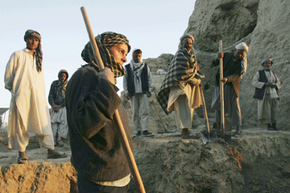The archaeologist and his team have been hard at work excavating an ancient site, digging deep into the sand of Egypt's Valley of the Kings. As the sun fades on the 120th day, a shout is heard near the dig's center. A hired hand has unearthed the entrance to the undiscovered tomb of an ancient pharaoh. The burial room is large and filled with a treasure trove of artifacts. After the initial euphoria over this cultural jackpot fades, a burning question sets in: Now what? Luckily for the archaeologist, there are a host of laws that spell out exactly what should happen next, laws that any legitimate archaeological team is bound to by an even stricter set of personal ethics.
The question of "who owns archaeological artifacts" isn't one that's easily answered. Each country and each region within each country has its own laws regarding the right to cultural property. Most of these laws have a set year established that draws the line between which objects belong to the state or country, and which are essentially "finders keepers." For instance, in New Zealand, all items found after April 1, 1976 are property of the Crown. The Antiquities Act of 1975 states that anything found must be reported to the Ministry of Culture and Heritage within 28 days. Then the ministry decides what to do with it. If the item was found before 1976, then it belongs to whoever found it.
Advertisement
Sweden has some of the most aggressive and specific laws pertaining to cultural finds. If more than one object is found at a single site, it must be reported to the government. The government encourages this by attaching a finder's reward to the object. If someone finds only a single object, they have to report it only if it's partly made of precious metals or copper alloy. If it's an ancient wooden bowl, then it's the finder's to keep, sell, or do whatever he or she would like to do with it. Here's where it gets tricky in Sweden: The actual land owner has very few rights. And since there are no laws in Sweden that forbid trespassing on private property, a person may cross through someone's yard, find an artifact and lay claim to it. And if you find that you have a genuine archaeological site discovered on your land, you may as well be a renter from the government.
In the United States, the National Historic Preservation Act and the Archaeological Resources Protection Act work hand in hand to both preserve and claim artifacts found on U.S. soil. These acts spell out what constitutes a historical site or archaeological resource site. For the latter, the site must be at least 100 years old, and remains must be related to past human life or activity. The acts also spell out strict penalties for persons found executing an excavation without a permit.
Legitimate archaeologists are in favor of these kinds of laws because they help protect the integrity of the site. Professionals in the field do not keep, sell or trade artifacts they uncover. Their goal is to record history, plain and simple, and if possible, move the objects as a collection for research and display. Anything found is property of the public, and it's the responsibility of the finder to care for the item for the sake of the public. If you aren't an archaeologist and you happen to stumble upon an artifact in the United States, then you must report your finding. Each state has an office of historical preservation or archaeology, as well as a state archaeologist. They're great resources and the perfect place to start if you find something that has cultural significance.
Advertisement

